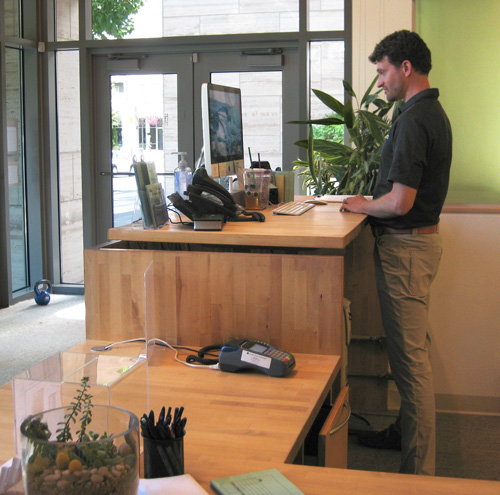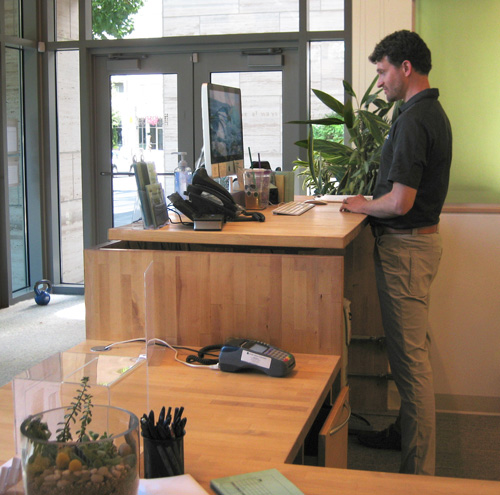
5 Reasons You Should Switch to a Standing Desk
Think standup desks are a recent trend or just a fad?
Leonardo Da Vinci used one. As did Benjamin Franklin, Ernest Hemmingway, Virginia Wolfe and Winston Churchill.
While these great figures didn’t have insights from recent scientific studies about sitting versus standing at work, they no doubt had good anecdotal reasons behind their decisions.
If you’re curious about the benefits of a standing workstation, or are debating whether or not to make the switch, this article highlights five reasons why we recommend the standing option along with a few tips for getting the most benefits from standing at work.
1) Increase your metabolism, decrease the chance of early mortality
As much as we’ve been told otherwise (or even instructed others), sitting still is not a good thing for us humans. In fact a recent Scientific American article, called Killer Chairs: How Desk Jobs Ruin Your Health goes as far as saying, “chairs are lethal.”1 A lack of movement for hours on end everyday takes a heavy toll on your body. Sitting simply uses less energy than standing, and recent studies have made strong connections between sitting, weight gain and a host of associated health problems—such as diabetes, heart disease and even certain types of cancers—in addition to a greater chance of early mortality.
Tip: Once you have a standing desk, don’t always stand in the same position. For example, shift your weight from leg to leg regularly and move around when talking on the phone. Even if you don’t currently have a standing workstation, or are unable to get one, take regular breaks to stand up and move around.
2) Activate your core, improve torso support
When you are seated, it’s easy to slouch and let the chair do much of the work of holding you in an upright position. Standing enables you to engage your core and legs and thus keep your body more active throughout the day.
Tips: To reset your posture while standing, do the following:
- Position your feet under your hips in a neutral, comfortable position and slightly contract your glutes.
- Breathe in deeply to straighten your posture, then maintain the posture (keep your ribs up) as you exhale.
- Slightly pull your shoulders down and back (while keeping your eyes at a neutral level looking ahead).
3) Increased productivity from improved blood flow and alertness
How many naps have you taken standing up? Standing, or at least having the option to stand, can give you a much-needed energy boost throughout the day. Part of the reason is because your body has to work harder to stand so it’s not as easy to nod off. In addition, when you are standing you can move around more easily. So if you are feeling tired, you can do little exercises or easily turn and engage co-workers to stay more alert. Many people report having more energy when they stand during the day rather than sit all of the time.
Tip: If it’s been a long time since you’ve done much standing, be sure to ease into the use of your standing work desk because your body will need time to adapt. We recommend that people work their way up to standing approximately 70 percent of the time and sitting for the other 30 percent. We also recommend that you change positions before you get fatigued rather than waiting until you feel exhausted.
You may also want to consider standing on a comfort mat, such as the Imprint CumulusPROTM mat to reduce fatigue in your feet and legs. Initially, it may seem like standing is more tiring, but over the course of a week or two it will start to feel normal, so give it time. You may even be amazed how much more energy you start to have in other settings, such as standing around at a networking event or watching a concert.
4) Improved posture

Tip: Just like with a seated desk, proper ergonomics are important for a standing workstation, so make sure your station is set up so that you can stand comfortably with proper posture. Ideally, you want your monitor to be at eye level directly in front of you, and your keyboard positioned so it is a natural extension of your arms when they are at 90 degrees.
5) Less pain and improved mobility
If you are not used to standing, then you probably associate being seated with being comfortable. It’s understandable because your body prefers what it’s used to. But if you consider the points about posture and energy above, then you start to realize that what your body is used to and what is good for your body are two very different things. In fact, some of your aches and pains at the end of the day may be more associated with sitting and a lack of movement than many other factors. Once your body starts to adapt to standing, some of your nagging aches and pains may decrease or even disappear as joint mobility and muscle strength improves.
Tip: Incorporate easy exercises or light stretches into your standing routine at work. For example, when you are doing light reading, try balancing on one leg for a few seconds and then switch to the other leg and repeat for 10 – 15 reps. Focus on maintaining proper posture throughout the reps.
Stand up for your health
If you research the benefits of standing desks, you will also find articles that suggest avoiding them. Some may suggest that it’s hard to concentrate on difficult tasks while standing, or that the leg and foot pain associated with standing isn’t worth it, in addition to other considerations. Even with these implications, the benefits of standing versus sitting can be dramatic.
Also, keep in mind that you don’t have to stand all of the time. Many standing desks raise are adjustable so you can keep a stool nearby for when you need a break or some extra brainpower. The important thing is to figure out what works for you. Choosing your health doesn’t have to break the bank, either; check out this list of adjustable desks that the researchers at Consumers Advocate have put together to see some of the options out there.
If you want more useful tips and information about how to better your health, sign up for our monthly newsletter! Have questions about the proper set up of a standup desk or want to schedule an appointment? Call us now at 503-227-2279 or 503-293-3001.
Source:
1, James Levine, Killer Chairs: How Desk Jobs Ruin Your Health, Scientific American, October 14, 2014.